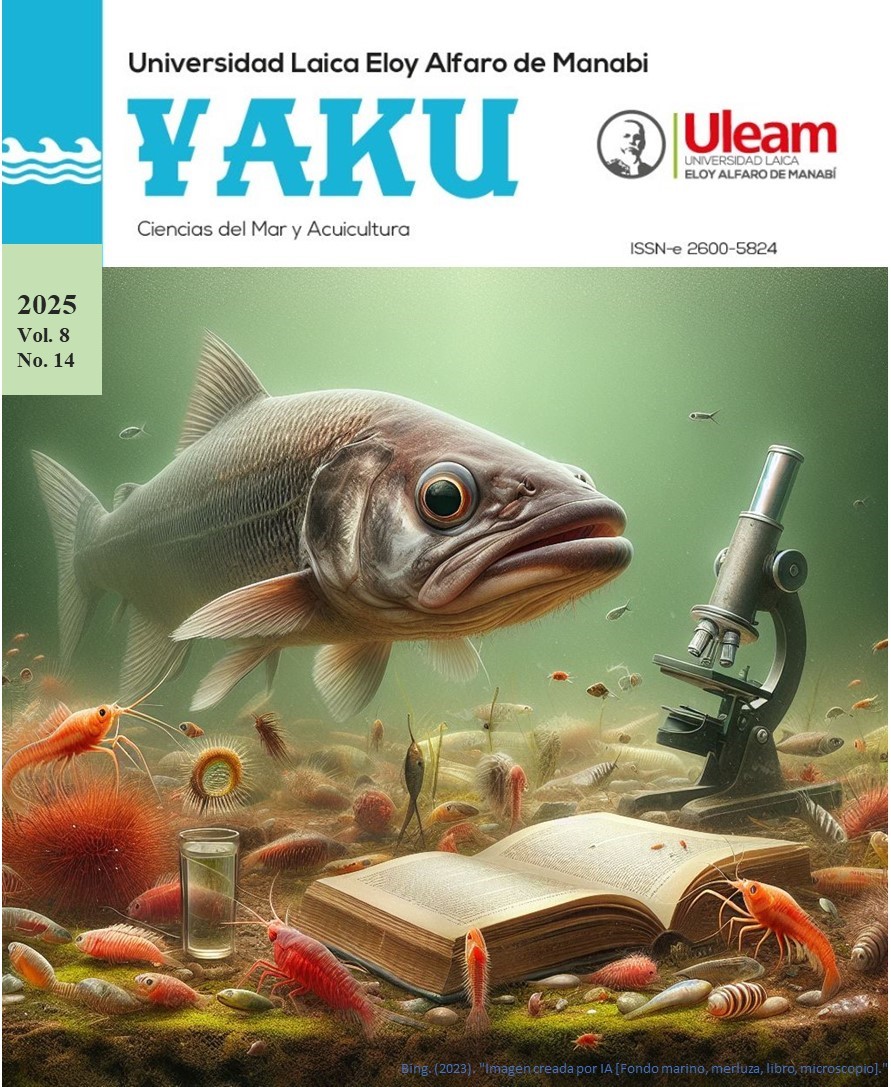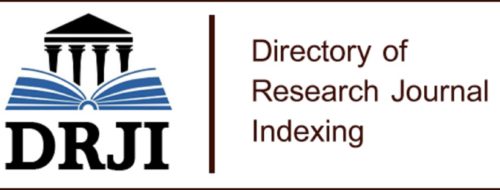Resistencia Antibiótica en Bioaerosoles Asociados a Lagunas de Oxidación
DOI:
https://doi.org/10.56124/yaku.v8i14.001Palabras clave:
bioaerosoles, aguas residuales, resistencia antibiótica, azitromicina, tetraciclina, lagunas de oxidaciónResumen
Se evaluó la relación entre los bioaerosoles generados en la laguna de oxidación de Calceta y la presencia de bacterias resistentes a altas concentraciones de azitromicina y tetraciclina. Se recolectaron muestras de bioaerosoles dentro y fuera de la laguna, hasta una distancia de 0.5 km, utilizando cajas Petri con Agar Nutritivo y dosis de antibióticos de 75 y 150 mg/L. Los resultados mostraron que los valores más altos de UFC se registraron en los testigos, mientras que los tratamientos con antibióticos redujeron significativamente el conteo bacteriano de manera dosis-dependiente, con las dosis altas (150 mg/L) siendo más efectivas al reducir las UFC a solo 2 colonias. Además, los bioaerosoles muestreados a mayor distancia de la fuente de agua residual y expuestos a antibióticos presentaron una disminución notable en la presencia de bacterias. Las dosis altas (150 mg/L) fueron más efectivas, reduciendo los conteos a niveles casi nulos, mientras que las dosis bajas (75 mg/L) resultaron menos eficaces. El análisis microbiológico identificó estafilococos Gram-positivos resistentes a antibióticos, destacando la adaptabilidad de los microorganismos a altas concentraciones de estos compuestos. Los resultados subrayan la necesidad de estrategias para mitigar la contaminación por antibióticos, como el tratamiento avanzado de aguas residuales y el monitoreo continuo de bacterias resistentes. Además, se resalta la importancia de investigaciones en Ecuador, dada la escasa evaluación de bioaerosoles en
Descargas
Citas
Ahmad, I., Malak, H. A., y Abulreesh, H. H. (2021). Environmental antimicrobial resistance and its drivers: A potential threat to public health. Journal of Global Antimicrobial Resistance, 27, 101-111.
Anjali, R., y Shanthakumar, S. (2019). Insights on the current status of occurrence and removal of antibiotics in wastewater by advanced oxidation processes. Journal of Environmental Management, 246, 51-62. https://doi.org/10.1016/j.jenvman.2019.05.090
Bai, H., He, L.-Y., Wu, D.-L., Gao, F.-Z., Zhang, M., Zou, H.-Y., Yao, M.-S., y Ying, G.-G. (2022). Spread of airborne antibiotic resistance from animal farms to the environment: Dispersal pattern and exposure risk. Environment International, 158, 106927. https://doi.org/10.1016/j.envint.2021.106927
Banchon, C. (2021). Airborne Bacteria from Wastewater Treatment and their Antibiotic Resistance: A Meta-Analysis. Journal of Ecological Engineering, 22(10), 205-214. https://doi.org/10.12911/22998993/142207
CDC. (2021). National Infection & Death Estimates for Antimicrobial Resistance. Centers for Disease Control and Prevention. https://shorturl.at/fgK08
CDC. (2024). Datos sobre el uso de antibióticos y la resistencia a los antimicrobianos. US Centers for Disease Control and Prevention (CDC). https://www.cdc.gov/antibiotic-use
Chen, M., Qiu, T., Sun, Y., Song, Y., Wang, X., y Gao, M. (2019). Diversity of tetracycline- and erythromycin-resistant bacteria in aerosols and manures from four types of animal farms in China. Environmental Science and Pollution Research, 26(23), 24213-24222. https://doi.org/10.1007/s11356-019-05672-3
Chen, Y., Yan, C., Yang, Y., y Ma, J. (2021). Quantitative microbial risk assessment and sensitivity analysis for workers exposed to pathogenic bacterial bioaerosols under various aeration modes in two wastewater treatment plants. Science of The Total Environment, 755, 142615. https://doi.org/10.1016/j.scitotenv.2020.142615
Chopra, I., y Roberts, M. (2001). Tetracycline Antibiotics: Mode of Action, Applications, Molecular Biology, and Epidemiology of Bacterial Resistance. Microbiology and Molecular Biology Reviews, 65(2), 232-260. https://doi.org/10.1128/MMBR.65.2.232-260.2001
Douglas, P., Robertson, S., Gay, R., Hansell, A. L., y Gant, T. W. (2018). A systematic review of the public health risks of bioaerosols from intensive farming. International Journal of Hygiene and Environmental Health, 221(2), 134-173. https://doi.org/10.1016/j.ijheh.2017.10.019
FAO. (2023). Resistencia a los antimicrobianos. Organización de las Naciones Unidas para la Alimentación y la Agricultura. https://www.fao.org/antimicrobial-resistance
Gaviria-Figueroa, A., Preisner, E. C., Hoque, S., Feigley, C. E., y Norman, R. S. (2019). Emission and dispersal of antibiotic resistance genes through bioaerosols generated during the treatment of municipal sewage. Science of The Total Environment, 686, 402-412. https://doi.org/10.1016/j.scitotenv.2019.05.454
Goddard, F. G. B., Pickering, A. J., Ercumen, A., Brown, J., Chang, H. H., y Clasen, T. (2020). Faecal contamination of the environment and child health: A systematic review and individual participant data meta-analysis. The Lancet Planetary Health, 4(9), e405-e415. https://doi.org/10.1016/S2542-5196(20)30195-9
Grossman, T. H. (2016). Tetracycline Antibiotics and Resistance. Cold Spring Harbor Perspectives in Medicine, 6(4), a025387. https://doi.org/10.1101/cshperspect.a025387
Habibi, N., Uddin, S., Behbehani, M., Kishk, M., Abdul Razzack, N., Zakir, F., y Shajan, A. (2023). Antibiotic Resistance Genes in Aerosols: Baseline from Kuwait. International Journal of Molecular Sciences, 24(7), 6756. https://doi.org/10.3390/ijms24076756
Han, I., y Yoo, K. (2020). Metagenomic Profiles of Antibiotic Resistance Genes in Activated Sludge, Dewatered Sludge and Bioaerosols. Water, 12(6), 1516. https://doi.org/10.3390/w12061516
Han, Y., Yang, T., Xu, G., Li, L., y Liu, J. (2020). Characteristics and interactions of bioaerosol microorganisms from wastewater treatment plants. Journal of Hazardous Materials, 391, 122256. https://doi.org/10.1016/j.jhazmat.2020.122256
Jelić, D., y Antolović, R. (2016). From Erythromycin to Azithromycin and New Potential Ribosome-Binding Antimicrobials. Antibiotics, 5(3), 29. https://doi.org/10.3390/antibiotics5030029
Kataki, S., Patowary, R., Chatterjee, S., Vairale, M. G., Sharma, S., Dwivedi, S. K., y Kamboj, D. V. (2022). Bioaerosolization and pathogen transmission in wastewater treatment plants: Microbial composition, emission rate, factors affecting and control measures. Chemosphere, 287, 132180. https://doi.org/10.1016/j.chemosphere.2021.132180
Kowalski, M., Wolany, J., Pastuszka, J. S., Płaza, G., Wlazło, A., Ulfig, K., y Malina, A. (2017). Characteristics of airborne bacteria and fungi in some Polish wastewater treatment plants. International Journal of Environmental Science and Technology, 14(10), 2181-2192. https://doi.org/10.1007/s13762-017-1314-2
Kusunur, A. B., Mogilipuri, S. S., Moturu, D., Benala, M., Vaiyapuri, M., Panda, S. K., George, J. C., y Badireddy, M. R. (2023). Tetracycline resistance potential of heterotrophic bacteria isolated from freshwater fin-fish aquaculture system. Journal of Applied Microbiology, 134(4), lxad060. https://doi.org/10.1093/jambio/lxad060
Lenth, R. V. (2009). Response-Surface Methods in R , Using rsm. Journal of Statistical Software, 32(7). https://doi.org/10.18637/jss.v032.i07
Li, J., Zhou, L., Zhang, X., Xu, C., Dong, L., y Yao, M. (2016). Bioaerosol emissions and detection of airborne antibiotic resistance genes from a wastewater treatment plant. Atmospheric Environment, 124, 404-412. https://doi.org/10.1016/j.atmosenv.2015.06.030
Liao, Q., Rong, H., Zhao, M., Luo, H., Chu, Z., y Wang, R. (2021). Interaction between tetracycline and microorganisms during wastewater treatment: A review. Science of The Total Environment, 757, 143981. https://doi.org/10.1016/j.scitotenv.2020.143981
Lou, M., Liu, S., Gu, C., Hu, H., Tang, Z., Zhang, Y., Xu, C., y Li, F. (2021). The bioaerosols emitted from toilet and wastewater treatment plant: A literature review. Environmental Science and Pollution Research, 28(3), 2509-2521. https://doi.org/10.1007/s11356-020-11297-8
Mainelis, G. (2020). Bioaerosol sampling: Classical approaches, advances, and perspectives. Aerosol Science and Technology, 54(5), 496-519. https://doi.org/10.1080/02786826.2019.1671950
Mirzaie, F., Teymori, F., Shahcheragh, S., Dobaradaran, S., Arfaeinia, H., Kafaei, R., Sahebi, S., Farjadfard, S., y Ramavandi, B. (2022). Occurrence and distribution of azithromycin in wastewater treatment plants, seawater, and sediments of the northern part of the Persian Gulf around Bushehr port: A comparison with Pre-COVID 19 pandemic. Chemosphere, 307, 135996. https://doi.org/10.1016/j.chemosphere.2022.135996
Niang, M., Reichard, J. F., Maier, A., Talaska, G., Ying, J., Santo Domingo, J., Varughese, E., Boczek, L., Huff, E., y Reponen, T. (2023). Ciprofloxacin- and azithromycin-resistant bacteria in a wastewater treatment plant. Journal of Occupational and Environmental Hygiene, 20(5-6), 219-225. https://doi.org/10.1080/15459624.2023.2205485
Osińska, A., Jachimowicz, P., Niestępski, S., Harnisz, M., y Korzeniewska, E. (2021). The effects of season and processing technology on the abundance of antibiotic resistance genes in air samples from municipal wastewater treatment and waste management plants. Environment Protection Engineering, 47(1). https://doi.org/10.37190/epe210108
Parnham, M. J., Haber, V. E., Giamarellos-Bourboulis, E. J., Perletti, G., Verleden, G. M., y Vos, R. (2014). Azithromycin: Mechanisms of action and their relevance for clinical applications. Pharmacology & Therapeutics, 143(2), 225-245. https://doi.org/10.1016/j.pharmthera.2014.03.003
R Core Team. (2020). A language and environment for statistical computing. R Foundation for Statistical Computing, Vienna, Austria. https://www.R-project.org/.
Singh, N. K., Sanghvi, G., Yadav, M., Padhiyar, H., y Thanki, A. (2021). A state-of-the-art review on WWTP associated bioaerosols: Microbial diversity, potential emission stages, dispersion factors, and control strategies. Journal of Hazardous Materials, 410, 124686. https://doi.org/10.1016/j.jhazmat.2020.124686
Tabrizi, A. M. A., Kakhki, S., Kakhki, S., Foroughi, M., y Azqhandi, M. H. A. (2022). Azithromycin resistance genes in Escherichia coli isolated from wastewater: Characterization and modeling-based evaluation of factors affecting the prevalence. Process Safety and Environmental Protection, 168, 32-41. https://doi.org/10.1016/j.psep.2022.09.067
Thaker, M., Spanogiannopoulos, P., y Wright, G. D. (2010). The tetracycline resistome. Cellular and Molecular Life Sciences, 67(3), 419-431. https://doi.org/10.1007/s00018-009-0172-6
Tripathi, N., y Sapra, A. (2024). Gram Staining. StatPearls [Internet]. Treasure Island (FL). https://www.ncbi.nlm.nih.gov/books/NBK562156/
UN Water. (2020). The United Nations World Water Development Report 2020 Water and Climate Change (p. 235). UNITED NATIONS EDUCATIONAL. https://unesdoc.unesco.org
UN Water. (2022). UN World Water Development Report. United Nations. https://www.unwater.org/publication_categories/world-water-development-report/
Xie, W., Li, Y., Bai, W., Hou, J., Ma, T., Zeng, X., Zhang, L., y An, T. (2021). The source and transport of bioaerosols in the air: A review. Frontiers of Environmental Science & Engineering, 15(3), 44. https://doi.org/10.1007/s11783-020-1336-8
Zhang, M., Zuo, J., Yu, X., Shi, X., Chen, L., y Li, Z. (2018). Quantification of multi-antibiotic resistant opportunistic pathogenic bacteria in bioaerosols in and around a pharmaceutical wastewater treatment plant. Journal of Environmental Sciences, 72, 53-63. https://doi.org/10.1016/j.jes.2017.12.011
Zieliński, W., Hubeny, J., Buta-Hubeny, M., Rolbiecki, D., Harnisz, M., Paukszto, Ł., y Korzeniewska, E. (2022). Metagenomics analysis of probable transmission of determinants of antibiotic resistance from wastewater to the environment – A case study. Science of The Total Environment, 827, 154354. https://doi.org/10.1016/j.scitotenv.2022.154354
Zieliński, W., Korzeniewska, E., Harnisz, M., Drzymała, J., Felis, E., y Bajkacz, S. (2021). Wastewater treatment plants as a reservoir of integrase and antibiotic resistance genes – An epidemiological threat to workers and environment. Environment International, 156, 106641. https://doi.org/10.1016/j.envint.2021.106641
Publicado
Cómo citar
Número
Sección
Licencia
Derechos de autor 2025 Revista de Ciencias del Mar y Acuicultura YAKU. ISSN: 2600-5824.

Esta obra está bajo una licencia internacional Creative Commons Atribución-NoComercial-CompartirIgual 4.0.


1.jpg)













